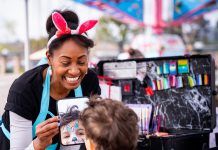It’s safer to take on the Mob Museum than the mob itself.
I had wanted to visit the Mob Museum in Downtown Las Vegas for years but didn’t have the opportunity to be in that area during my previous trips to Las Vegas. When I was staying in the Fremont East area the museum was more accessible, so I dropped by.
Admission for non-residents was $23, but an annual membership with unlimited admission for a year was $30. That was an offer I couldn’t refuse.
My annual membership also includes discounts on merchandise and food – I’m trying to figure out whether I also get a discount on cement back home. My membership also allowed me to have an audio tour.
During my first visit to the Mob Museum I was able to sit in the electric chair and have my photo taken – fortunately the switch activates the lights rather than the electric chair itself, since the Denny’s all-you-can-eat pancakes special isn’t my idea of a last meal.
The courtroom where Senator Kefauver chaired one of the hearings on organized crime was in the building, and some of the furniture from the 1950 hearing is still in that room.
One of the member discounts gave me a hot bourbon and cider for $5.
I was allowed to take that into the hearing room – how often can you drink liquor in a courtroom?
Even though membership dues increased to $45 the following year I still renewed. Back in San Diego I was going through San Diego Union microfilm reels for a history book project and came across some finds I thought the Mob Museum archives might appreciate. Two of Tom Blair’s 1986 columns had items about Moe Dalitz, who supplied liquor during Prohibition and eventually became a fixture at San Diego County’s La Costa resort, being treated in Scripps Clinic’s cardiac care unit. I sent those to the Mob Museum for their archives.
I later found four 1988 San Diego Union profiles regarding interaction on various levels with Al Capone. One of them was on Tony Berardi, who was the first photographer on the scene at the St. Valentine’s Day Massacre.
The Chicago building where seven of Bugs Moran’s assistants were fatally shot was dismantled in 1967.
A collector in British Columbia purchased the wall where the shooting occurred, and after the Mob Museum opened the wall was purchased from the collector’s family and is now one of the museum displays.
Excluding those who did the shooting there was one survivor: a German shepherd named Highball who had been tied to a car bumper.
According to the museum display by the wall the dog was so traumatized he had to be put down.
The Aug. 1, 1988 San Diego Union profile included two quotes from Tony Berardi on Highball.
The first was: “The only thing alive I found was a German shepherd watching, shivering in fright.” (The one Moran associate who was still alive and died while being transported to the hospital had been removed before Berardi arrived.)
The other reference to the German shepherd concluded the article: “And the dog? I gave him to Jack Miller, who put him on his family’s farm up in Wisconsin.”
The San Diego Union article I have contradicted the museum display. I could forget about it, or I could challenge the museum.
The latter was more in spirit with the mob atmosphere.
I had made a copy of the article shortly before my next trip to Las Vegas, so I planned to hand-deliver the three articles I had copied.
I brought the articles and the cover letter to the admission window and was told the curator doesn’t work out of the museum, but I was given Carolyn’s direct number.
I called her that day but received her voicemail.
I called Carolyn again two days later.
She remembered the articles I sent her on Moe Dalitz, and she told me to mail the profiles after I returned home instead of hand-delivering them.
I sent the articles to Carolyn the week I returned home.
Since I haven’t been threatened, taking on the Mob Museum is apparently safe.
Then again maybe they figure that if I’m old enough to know how to use a microfilm reader my kneecaps are going to get broken without hitman intervention.













